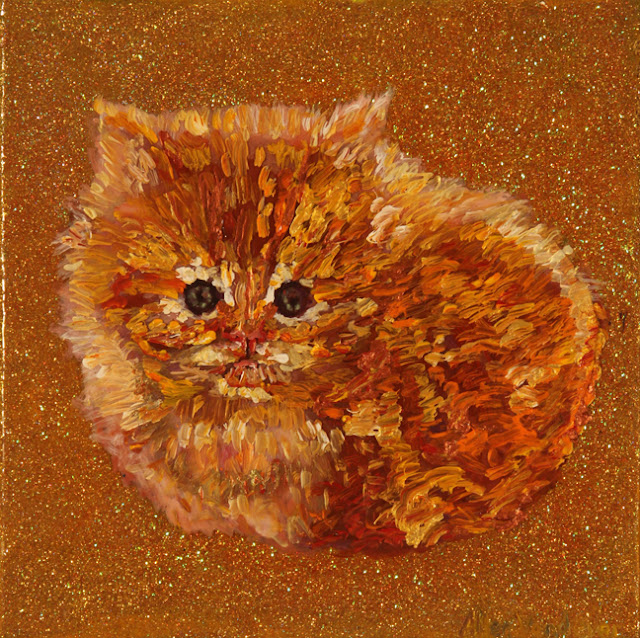This is an article from the Chicago Sun-Times may 22 2011 about my first Recsue and Destroy event
‘You have four minutes to save this painting!” proclaimed Allen Vandever — bald, bearded, 6 foot 3 — addressing the crowd gathered around his booth at Art Chicago on Saturday afternoon. “Eight have been rescued; five have been destroyed.”
On the walls, Vandever’s paintings of cute kittens and cuter puppies, done in a loose, colorful style and set against glittery backgrounds of magenta and teal and orange.
One painting — a happily panting puppy — was set on an easel behind an altar on the floor: four sturdy 4-by-4 beams with the chopped up wreckage artworks piled around them. A red fire ax hung on the wall.
“Three minutes and 45 seconds to save the puppy!” Vandever said, reading a timer ticking down the seconds on an iPad.
“Somebody save the puppy!” cried Jill Dunbar, his confederate, wearing a skirt and bright blue sweater, the thrift shop ensemble that is practically a uniform for artsy types.
Art is a scam. That’s why there is a tiger shark suspended in formaldehyde at the Metropolitan Museum of Art. But like magic, art is a pleasurable scam, if done right, a voluntary scam where the audience consents to the deception. The first few times I passed Vandever at his Team Art booth in the Next portion of Art Chicago, on the 12th floor of the Merchandise Mart, I noted the crowd, and the ax, and the patter, and kept walking.
But eventually I stopped. Maybe because my wife was with me — I usually visit Art Chicago two or three times during its long weekend run. There’s lots to see.
Vandever, wearing baggy striped pants, a flowery shirt, shoeless, took the ax down from the wall. “Two minutes and 55 seconds left,” he announced.
Someone in the crowd of 25 offered $20.
“I will not work for under minimum wage,” he declared, adding that the painting took 10 hours to create, a claim that may be true, if you include drying time.
“Forty-five seconds,” he said, then began counting down. “Five, four, three, two, one . . .”
Nobody saved the puppy, and Vandever used the ax to chop it apart.
I went up to talk to the artist. “You didn’t seem very hesitant about chopping up your painting,” I said.
“The first time was very liberating,” he said. “We’re letting the audience decide if it has value or not, if it should continue to exist.”
Each painting on the wall had a title, a price — the puppy had been $1,200— and a time when it would go under the ax. Next to the puppy was an orange kitty against a sparkly emerald green background. Its appointed rendezvous with the ax: 3 p.m.
My wife liked it.
We wandered the show. Next, the younger, edgier, cheaper version of Art Chicago, used to be on a separate floor. This year both are on the same floor, to the dismay of high-end galleries forced in proximity to Next’s Barbie-limbs-and-ironing-board sculpture, hey-kids-let’s-do-art aesthetic. “I don’t want to be next to Next,” one owner complained.
At 10 to 3, we drifted back to Team Art.
“It’s not a real kitty, you know,” I said, in vain. By then we were watching Vandever.
“In four minutes this ax and this kitty will have a violent encounter,” Vandever said, tapping the blunt end of the ax on the kitten painting. “It’s up to you to decide whether this painting deserves to be in existence or not.”
“What kind of society are we?” cried Dunbar. “A kitty cat!”
With two minutes left, my wife offered $50 and was rebuffed with the minimum wage claim. She immediately upped it to $75 and the kitty was spared; there were boos from the audience, who had been waiting for minutes and wanted to see art axed apart.
“People really want to see destruction,” said Dunbar, as she wrapped our purchase. “They see it on TV. I guess that’s our society.”
“It is a little distressing to see people who want the art destroyed,” said Vandever, whose previous works focused on couples in explicit sex acts. And then there are those who shout out offers of a dollar or two.
“A jab in the heart,” Vandever said, sadly.
We took our kitty home and hung her in the foyer, where the glitter in the background harmonizes nicely with the sequins in the Haitian voodoo drapeaux nearby. The beautiful thing about spending 75 bucks for a painting is: very little buyer’s remorse.
“I couldn’t let them chop up that kitty,” my wife said. The ax shtick may not be something that van Gogh would have tried, but van Gogh never sold a painting in his lifetime. A fire ax is underappreciated as an artist’s tool.
Besides, it is a cute kitten.






















